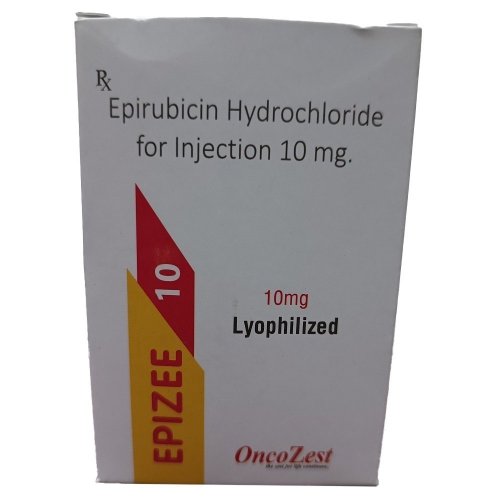Product Intro:
Epizee is formulated as a sterile, preservative‑free lyophilized powder for reconstitution and intravenous infusion. It is designed to deliver epirubicin with controlled pharmacokinetics, minimizing peak plasma levels to reduce cardiotoxicity while maintaining antitumor efficacy. Approved for use in breast, ovarian, gastric, lung cancers, and non‑Hodgkin’s lymphoma, Epizee is often combined with other agents in multi‑drug regimens.
Uses (Indications):
-
Breast Cancer: Early‑stage (adjuvant) and metastatic disease, often in combination with cyclophosphamide and 5‑FU.
-
Ovarian Cancer: First‑line or recurrent disease, frequently combined with platinum agents.
-
Gastric (Stomach) Cancer: In advanced or metastatic settings as part of combination regimens.
-
Non‑Hodgkin’s Lymphoma: When anthracycline‑containing protocols (e.g., CHOP) are indicated.
-
Lung Cancer: Non–small cell lung carcinoma in combination chemotherapy.
-
Soft Tissue Sarcomas and Other Solid Tumors: Under clinical protocols when anthracyclines are appropriate.
Storage Instructions:
-
Store at 2 °C to 8 °C in a refrigerator—do not freeze.
-
Protect from light—keep vials in the original carton until use.
-
Inspect for particulate matter or discoloration prior to reconstitution.
-
Once reconstituted, use immediately or store at 2 °C to 8 °C and discard any unused portion after 24 hours.
How It Works (Mechanism of Action):
Epirubicin intercalates between DNA base pairs and inhibits topoisomerase II, preventing relegation of DNA strands. It also generates reactive oxygen species, causing oxidative damage to nucleic acids and cell membranes. These dual actions arrest the cell cycle in S‑ and G2‑phases and trigger apoptotic pathways in rapidly dividing tumor cells.
Side Effects:
Common Side Effects:
-
Myelosuppression: Neutropenia, thrombocytopenia, anemia—typically nadir at days 10–14.
-
Nausea and Vomiting: Moderate to severe—antiemetic prophylaxis recommended.
-
Alopecia: Reversible hair loss beginning 2–4 weeks after treatment.
-
Mucositis: Oral and gastrointestinal ulcerations.
-
Injection Site Reactions: Pain, erythema if extravasation occurs.
Serious Side Effects:
-
Cardiotoxicity: Cumulative dose–dependent risk of cardiomyopathy and congestive heart failure—monitor LVEF.
-
Severe Infections: Due to profound neutropenia—risk of sepsis.
-
Extravasation Injury: Tissue necrosis if leak outside vein occurs—requires specific antidote (dexrazoxane).
-
Secondary Malignancies: Therapy-related acute myeloid leukemia or myelodysplastic syndrome with long‑term exposure.
-
Hepatotoxicity: Elevated liver enzymes in patients with preexisting dysfunction.
Dosage (Typical Recommended Dose):
-
Breast Cancer (Adjuvant): 75 mg/m² IV every 3 weeks for 4–6 cycles.
-
Metastatic Breast Cancer: 90–100 mg/m² IV every 3 weeks, adjusted for prior anthracycline exposure.
-
Ovarian Cancer: 60–75 mg/m² IV every 3 weeks in combination protocols.
-
Lymphoma (CHOP Regimen): 50 mg/m² IV on day 1 every 21 days.
-
Dose Adjustments: Required for hepatic impairment—reduce by 25–50% if bilirubin elevated or AST/ALT >2.5× ULN.
Method of Administration:
-
Reconstitute vial with sterile water for injection to obtain concentration of 2 mg/mL.
-
Dilute further in 250–500 mL of D5W or NS for infusion.
-
Infuse over 3–5 minutes (bolus) or over 15–30 minutes depending on institutional protocol—do not exceed 10 mg/min.
-
Use central venous access when possible to minimize extravasation risk.
-
Flush line thoroughly before and after to prevent precipitation.
Precautions:
-
Baseline Cardiac Assessment: Echocardiogram or MUGA scan—repeat periodically when cumulative dose approaches 300 mg/m².
-
Hematologic Monitoring: CBC with differential prior to each cycle—delay therapy if ANC <1.5 × 10⁹/L or platelets <100 × 10⁹/L.
-
Hepatic Function Tests: Prior to each dose—avoid if severe impairment.
-
Extravasation Protocols: Have dexrazoxane and hyaluronidase ready.
-
Pregnancy Category D: Contraindicated—advise effective contraception during and 6 months after therapy.
-
Breastfeeding: Not recommended—drug is excreted in milk.
Drug Interactions:
-
CYP3A4 Inhibitors (e.g., ketoconazole): May increase epirubicin plasma levels and toxicity.
-
CYP3A4 Inducers (e.g., rifampin): May reduce efficacy by accelerating clearance.
-
Other Cardiotoxic Agents (e.g., trastuzumab): Additive cardiac risk—monitor closely.
-
Anticoagulants (e.g., warfarin): Increased bleeding risk with thrombocytopenia—monitor INR and platelet counts.
-
Live Vaccines: Contraindicated during profound immunosuppression.
Allergies (Warnings for Allergic Reactions):
-
Hypersensitivity Reactions: Rare anaphylactoid responses—flushing, dyspnea, hypotension—stop infusion immediately.
-
Skin Testing: Not routinely done; manage acute reactions with antihistamines and corticosteroids.
-
Vigilance: Always have resuscitation equipment and emergency drugs at hand.
Overdose Information:
-
Symptoms: Profound myelosuppression, severe mucositis, cardiotoxicity signs, hepatotoxicity.
-
Management: Supportive care—G‑CSF for neutropenia, transfusions, and intensive cardiac monitoring.
-
No Specific Antidote: Treat extravasation with local dexrazoxane and supportive wound care.
Missed Dose Instructions:
-
Contact Oncologist: Immediately if a cycle is missed due to toxicity or scheduling.
-
Do Not Self‑Administer: All doses must be delivered under medical supervision.
-
Reschedule: Based on hematologic recovery and clinical status—maintaining cycle length is important for efficacy.
Additional Notes:
-
Cumulative Dose Limit: Generally recommended not to exceed 900 mg/m² lifetime to reduce heart failure risk.
-
Patient Education: Explain red discoloration of urine—harmless and transient.
-
Supportive Medications: Antiemetics (5‑HT₃ antagonists), growth factors, and cardioprotectants (dexrazoxane) as indicated.
-
Long‑Term Follow‑Up: Monitor for late cardiomyopathy and secondary malignancies.
-
Multidisciplinary Care: Coordination between oncology, cardiology, pharmacy, and nursing is critical for safe administration.



